|
Map of Huron county circa 1870. ( Note: Lake Township)
Lake Township was organized in 1867 by special act of the legislature. Its territory was taken from that of Grant and Caseville. John B. Woodhull was the first supervisor and Robert Gotts clerk. There were 21 voters at the first election. The first settler was William Fisher in 1859. Robert Gotts and Hannah Davison were the first couple married in the township in 1866. Mr. Gotts told the following story of his coming into this section: "I had a longing to own a bit of this green earth, so came here in 1864. I found my land was three miles from the nearest neighbor. Had to cut a trail through the woods, which took several days. Built a small shanty, got in some provisions and settled down for a long winter of solitary life.
Early 1900 Gotts Settlement
Present area of the Gotts Settlement ( Note: Township Hall ) Owing to a mistake in locating the lands by the parties who helped me, found the next spring that I had chopped on the wrong land all winter. Had to begin all over again. For many years there were no bridges across the Pigeon river, so often in the winter time had to break the ice where it was not frozen hard enough to bear the weight of a man and wade or pole a raft across with the necessary supplies. As soon as I had a clearing large enough to raise grain I bought two and one-half bushels of spring wheat for $3.00 per bushel. Had to carry it on my back for four miles, then plant it with a hoe. The next year sowed 12 bushels of oats, which I also carried in, bringing two bushels at a time. Generally the implements the pioneer had were an axe, hoe, handspike, shovel and a grindstone, until the fires of '71 and '81 let in the sunshine and the wind. This made it possible to burn the timber more easily.
|
|
The problem in those days was not how to get timber, but how to get rid of it. The first school was organized in 1864.Three men who leaned toward the Presbyterian Church, the Primitive Methodists and the Church of England started the first Sunday school. These three promoters asked the people to bring their Bibles. When Sunday came the schoolhouse was full. Then came a problem. Who would open the session with prayer? Finally they solved the question by repeating the Lord's Prayer and the Apostle's Greed. Some one suggested that they have singing, so the Scotchman selected a hymn out of the Westminster hymnal and the first Psalm. The Sunday school proved to be a success, but the school house burned in the fire of '81 and that ended the work." Lake Township is drained by the Pigeon and Pinnebog rivers. The soil is a clay loam except along the shore. The great fires of ‘71 and ‘81 touched about one-third of the township. William Dufty bought 160 acres of land in 1865. He married Mary Ann Smith, who with her parents came to Caseville Township from Pennsylvania in 1861. Two families settled in Lake in 1859-Thomas McCormick and Archie McIlhargey. When we read this early date we have but a faint conception of what life then meant in a dense wilderness. Take away the roads and bridges and every vestige of the white man's improvements and restore the wooded territory of 1859 and then imagine these pioneers with their families, effects and whatever fortune they might possess embarking oft times on a rudely constructed "jumper" drawn by a team of oxen, making the irksome journey over winding trails into the land of their future homes. Here surrounded by the trees of the forest in which wild animals abounded they made the little clearings and built the log cabins. There were days of privation and scanty fare but many of them lived to see this region rise from ague swamps and tangled forests into the charms of health and vast prosperity. Even as late as 1874 Mr. Musselman in the woods near his home killed two cubs and attacked the old bear but she showed Fight and he had to flee for his life.
Early Logging camp near Lake Township 1870
Among these early settlers we find the names of M. C. Smalley, George Henry, Samuel Lewis, H. Champagne, Ingraham, Harrison and Lewis H. Guyeau, whose life history would tell many incidents of that period. Rush Lake is situated in this township, just south of the Babbitt Quarries. It was originally about two and one half miles long and about a mile wide. This lake is somewhat higher than Lake Huron, which is within a mile of it but the ridge of sand stone between them prevents direct drainage. There is a large island in this lake and some fish. A splendid quality of high bush huckleberries grow on the Island which is thickly covered with a growth of spruce and other shrubs, making it difficult to go in any direction other than along the trails which form a maze as they zigzag to every point of the compass. The ground is mossy and yielding except where the roots of the trees so near the surface form a network. Many wild fowl come here in the fall, as it is a natural habitat for water birds. In late years drains running east towards the Pinnebog and west to the Pigeon Rivers have lowered the level of the lake and reduced its size. Along its shores the Upthegrove families settled and the home of Mr. Chapman was near the Babbitt Quarries. He was one of the early teachers in the Caseville School.
A Special Thanks to the Deckerville Public Library
|



